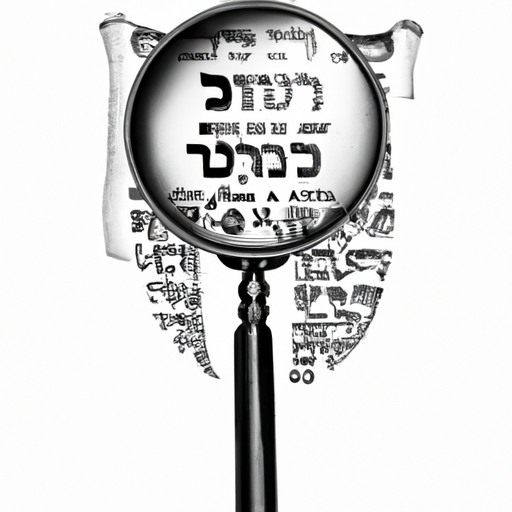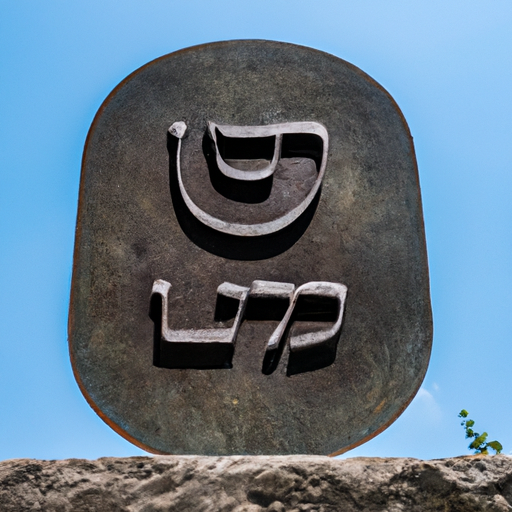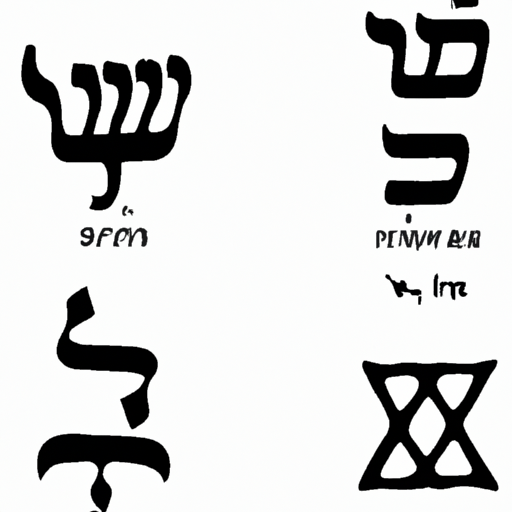In recent years, Hebrew tattoos have gained popularity among people from various backgrounds and cultures, intrigued by the ancient language’s mystique and symbolism. However, this growing trend has also given rise to a plethora of mistakes, controversies, and debates. From incorrect translations to cultural appropriation, the world of Hebrew tattoos is as fascinating as it is complex. In this article, we will delve into the most common errors found in Hebrew tattoos and offer guidance on how to avoid them, explore the evolution of Hebrew tattoos from ancient symbols to modern art, and discuss the heated debates surrounding the meanings and cultural significance of these tattoos. Whether you’re considering getting a Hebrew tattoo yourself or simply curious about this intriguing phenomenon, join us on this enlightening journey into the world of Hebrew ink.
- 1. "Lost in Translation: Common Hebrew Tattoo Errors and How to Avoid Them"
- 2. "From Ancient Symbols to Modern Art: The Evolution of Hebrew Tattoos"
- 3. "Inked Debates: Exploring the Controversy Behind Hebrew Tattoos and Their Meanings"
1. "Lost in Translation: Common Hebrew Tattoo Errors and How to Avoid Them"

Lost in Translation: Common Hebrew Tattoo Errors and How to Avoid Them
Hebrew tattoos have become increasingly popular over the years, as people look to express their spirituality, commemorate a loved one, or simply make a statement with their body art. However, Hebrew is a complex language with unique characters and grammar rules, making it all too easy for tattoo designs to go awry. In this section, we will explore some of the most common Hebrew tattoo errors and how you can avoid making the same mistakes.
1. Incorrect spelling: Hebrew is written from right to left, which can be confusing for those accustomed to English and other left-to-right languages. Ensure your tattoo artist is well-versed in Hebrew lettering and can accurately spell the word or phrase you want. Double-check the spelling with a native Hebrew speaker before getting inked.
2. Mistranslation: Even if the letters are correctly written, the meaning of the word or phrase may be lost due to a mistranslation. Using online translation tools can lead to inaccurate translations, as they often do not account for context or idiomatic expressions. Consult with a Hebrew language expert or native speaker to ensure the correct translation.
3. Inappropriate use of sacred texts: While many people choose to have Hebrew tattoos as a symbol of their faith, care should be taken when selecting religious texts. Some verses or phrases may be considered disrespectful or inappropriate to wear on the body. Seek guidance from a religious leader or knowledgeable community member before choosing a sacred text for your tattoo.
4. Incorrect letter placement: Hebrew letters have specific positions when written in a word, and altering the placement can change the meaning or make the word nonsensical. Ensure your tattoo artist understands the importance of correct letter placement to avoid any issues.
5. Unintended double meanings: Hebrew is a language rich in wordplay and double meanings. Be aware that your chosen word or phrase may have an unintended second meaning or connotation, which could be embarrassing or offensive. Consult with native speakers or language experts to avoid any misunderstandings.
To avoid these common Hebrew tattoo errors, take the time to research your chosen design carefully. Consult with Hebrew language experts, religious leaders, and native speakers to ensure your tattoo accurately reflects your intended meaning. By taking these precautions, you can prevent the disappointment of a mistranslated or inappropriate Hebrew tattoo and enjoy a meaningful and beautiful piece of body art.
2. "From Ancient Symbols to Modern Art: The Evolution of Hebrew Tattoos"

Hebrew tattoos have come a long way from their ancient origins to the contemporary designs we see today. With a rich history that dates back thousands of years, Hebrew tattoos have evolved in both form and meaning, reflecting the changing cultural and religious landscape of the Jewish people. In this section, we will explore the transformation of Hebrew tattoos from ancient symbols to modern art.
The roots of Hebrew tattoos can be traced back to ancient Jewish tradition and culture. Tattooing was a common practice in ancient Middle Eastern societies, and Hebrew inscriptions and symbols have been discovered on mummies dating back to the 8th century BCE. These early tattoos often carried spiritual or protective meanings, such as the "Shema Yisrael" prayer, one of the central prayers in Judaism. However, it is important to note that tattooing was not universally accepted in ancient Jewish culture. The Torah, the sacred text of Judaism, prohibits the marking of the skin, which has led to an ongoing debate about the appropriateness of Hebrew tattoos.
Despite the religious prohibition, Hebrew tattoos continued to evolve and adapt to the changing times. During the Middle Ages, Jewish mystics known as Kabbalists began to incorporate Hebrew letters and symbols into their spiritual practices. These symbols, drawn from the mystical text known as the Zohar, were believed to have divine power and were used for protection, meditation, and healing. This period saw the rise of intricate and highly symbolic Hebrew tattoos, often incorporating elaborate geometric patterns and the sacred Hebrew alphabet.
In modern times, Hebrew tattoos have taken on new forms and meanings, reflecting the diverse cultural influences of the Jewish diaspora. Today, these tattoos can be found in a variety of styles, ranging from traditional calligraphic designs to more abstract and artistic interpretations. Some popular Hebrew tattoos include the "Chai" symbol, which represents life and is often used as a symbol of Jewish identity, and the "Hamsa," a hand-shaped symbol believed to ward off the evil eye.
Contemporary Hebrew tattoos often serve as a means of expressing personal beliefs and values, as well as a connection to Jewish heritage and identity. For some, these tattoos may represent a form of spiritual expression, while for others, they may serve as a reminder of a significant life event or a tribute to a loved one. In this sense, Hebrew tattoos have evolved from their ancient origins as protective symbols to a modern form of personal expression and reflection.
However, as Hebrew tattoos have gained popularity, so too have instances of poorly executed or mistranslated designs. The complexity of the Hebrew language and alphabet can make it difficult for non-native speakers to accurately convey their intended meaning, leading to embarrassing and sometimes offensive mistakes. It is crucial for anyone considering a Hebrew tattoo to thoroughly research and consult with native speakers or experts to ensure the accuracy and appropriateness of their design.
In conclusion, Hebrew tattoos have experienced a fascinating evolution from ancient symbols to modern art, reflecting the rich history and culture of the Jewish people. As these tattoos continue to adapt and transform, they serve as a testament to the enduring power of language and the human desire to connect with our heritage and beliefs.
3. "Inked Debates: Exploring the Controversy Behind Hebrew Tattoos and Their Meanings"

Inked Debates: Exploring the Controversy Behind Hebrew Tattoos and Their Meanings
Hebrew tattoos have become increasingly popular as a form of self-expression, spirituality, and connection to the Jewish faith or culture. While many people view these tattoos as symbols of pride and identity, there is no denying that they come with a fair share of controversy. In this section, we’ll delve into some of the contentious debates surrounding Hebrew tattoos and their meanings.
1. Religious Prohibitions and Taboos: One of the primary sources of controversy surrounding Hebrew tattoos is the fact that they are explicitly forbidden by Jewish law. According to Leviticus 19:28, "You shall not make gashes in your flesh for the dead, or incise any marks on yourselves: I am the LORD." This verse is commonly interpreted as a prohibition against tattoos, and as such, many observant Jews consider it a violation of Jewish law to get inked. Critics argue that Hebrew tattoos are disrespectful to the faith and can even be seen as a form of cultural appropriation when worn by non-Jews.
2. Inaccurate Translations and Misinterpretations: Another issue that has sparked debate among Hebrew tattoo enthusiasts is the prevalence of incorrect translations and misinterpretations. There have been numerous instances where individuals have ended up with tattoos that do not convey the intended meaning, due to errors in translation or a lack of understanding of the nuances of the Hebrew language. These mistakes can lead to embarrassment and ridicule, as well as perpetuate misconceptions about the language and its cultural significance.
3. Political and Social Implications: Some Hebrew tattoos carry political or social connotations that can lead to controversy. For example, tattoos featuring the Star of David, a symbol of Judaism and the State of Israel, can be seen as making a political statement, particularly in the context of the Israeli-Palestinian conflict. Additionally, tattoos with Hebrew phrases or symbols related to the Holocaust or other sensitive historical events can be viewed as offensive or disrespectful by some.
4. Cultural Sensitivities: Lastly, the debate surrounding Hebrew tattoos often centers on questions of cultural sensitivity and appropriation. Some argue that non-Jews getting Hebrew tattoos are trivializing or commodifying a language and culture that they do not fully understand or belong to. This debate is particularly relevant in the case of celebrities and public figures, whose Hebrew tattoos are often in the public eye and can influence trends and perceptions of the language and culture.
In conclusion, the controversy surrounding Hebrew tattoos and their meanings is multifaceted, touching upon religious, cultural, and political sensitivities. As with any tattoo, it is essential for individuals considering a Hebrew tattoo to do their research, consult with experts, and be mindful of the potential implications of their chosen design. Ultimately, the decision to get a Hebrew tattoo is a personal one, and open dialogue and understanding can help to bridge the gap between conflicting perspectives.
In conclusion, Hebrew tattoos are a unique way for individuals to express their personal beliefs, cultural heritage, or artistic preferences. However, it is crucial to be aware of the potential pitfalls and controversies surrounding these tattoos to make an informed decision before getting inked. By learning from the mistakes highlighted in the Bad Hebrew Tattoos Blog and taking the time to fully understand the meanings and history behind the symbols, one can avoid becoming another cautionary tale. Additionally, engaging in open and respectful discussions about the controversies surrounding Hebrew tattoos can help to foster understanding and appreciation for the rich cultural and historical significance of these designs. Ultimately, the decision to get a Hebrew tattoo is a deeply personal one, and with careful consideration and research, one can make a choice that is both meaningful and respectful.